'Star Wars: The Last Jedi' production designer reveals new cut scene, teases Luke's possible return (exclusive)

The time has come for a fresh appraisal of Star Wars: The Last Jedi, as Rian Johnson’s sci-fi spectacular will available to watch at home from Monday, 9 April.
Episode VIII, which arrived in cinemas in December last year, remains a divisive instalment in the 40-year-old film franchise with many vocal fans still complaining online about its various twists, turns, and diversions from the established lore.
The home release will give fans on both sides of the divide the chance to rewatch the film, free from the weight of expectation built up over the two years of waiting since The Force Awakens.
Many will probably still only be able to see fault, but hopefully many will be able to recognise the film for what it is: a bold new take on a tired old story.
Its production designer, Rick Heinrichs, who spoke to Yahoo Movies to support the film’s release on Digital Download, 4K Ultra HD, Blu-ray and DVD, unsurprisingly supports his director’s vision.

“I think that history is going to look kindly on [The Last Jedi],” Heinrichs, whose previous work includes Pirates of the Caribbean and Captain America, tells Yahoo. “I think it’s an incredible film, I think that it’s a dynamic film and that, in many respects, it’s clearing the way for an amazing Episode IX.”
Many fans, who wanted more of the same after the relatively safe story-telling of The Force Awakens, will be looking forward to J.J. Abrams’ return for Episode IX. Heinrichs himself, is also looking ahead to 2019, where he hopes a certain last Jedi may return.
“I have a feeling this isn’t the last you’re going to see of Luke Skywalker… That’s only a guess,” he laughs, “I’m not allowed into the inner sanctum!”
Here’s everything we learned from Rick Henrichs about the production design of The Last Jedi, including a deleted scene on Crait, the intricate complications of the Fathiers, and the influence of Ralph McQuarrie that still looms over the franchise…
Yahoo Movies: Congratulations on The Last Jedi, it’s been a huge success. This was your first Star Wars movie, so presumably you were mega-excited to work on it?
Rick Heinrichs: I was very excited to work on it. I was a huge fan, particularly since I saw the first film come out at the theatre. I was in my late teens, early twenties; for Rian [Johnson] I think it was a little bit different, he was a kid and so for him Star Wars really was playing with the vehicles and all of that.
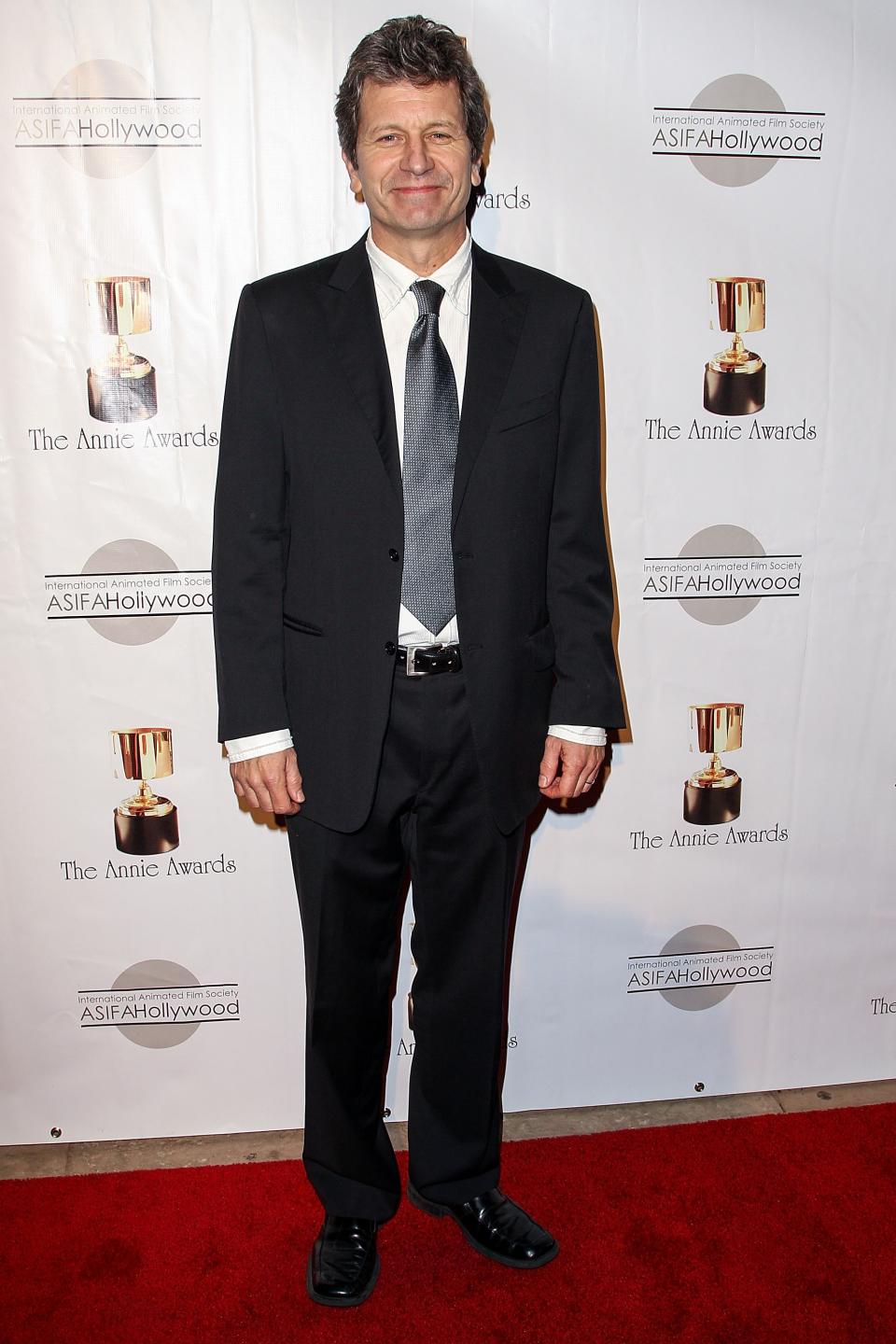
For me it was just a mind-blowing experience to see all the visual effects in combination with the story and with those characters. It seemed to come out of nowhere with that great [George] Lucas sort-of documentary style.
He just sprang it on the world. You’d just slip right into the middle of the action like one of those old Flash Gordon pictures and feel like you were really right there and everything was just perfect normal.
You’re on the Death Star and that’s a normal day in Star Wars land!
Describe to me the first time you sat down with Rian Johnson and discussed the look and the feel of The Last Jedi.
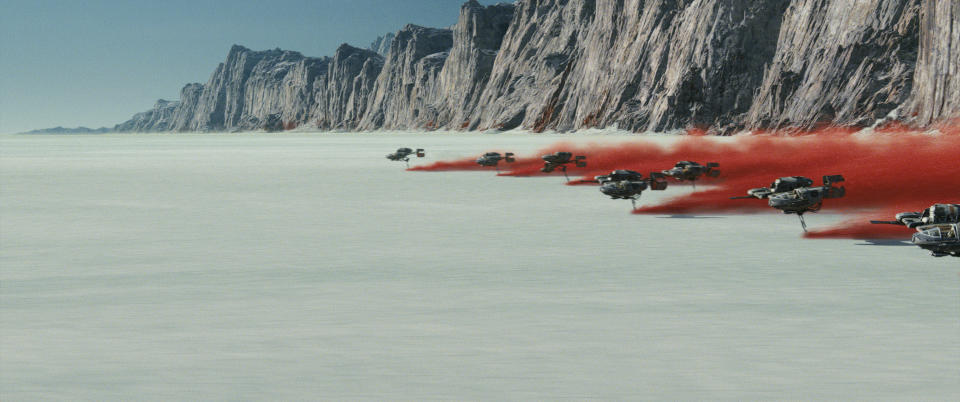
When I was still finding out about it, he pitched me a story and what came to me was that he was somebody who really grasped the big themes and character arcs of the Star Wars legacy.
He was attempting to build on that and develop it for today’s audience and make it accessible to everybody, to make them as excited as he was to see it. He had a very simple, graphic feel for what he was describing. Nothing was too specific except for a couple of things.
We were trying to figure out what [mining planet] Crait was, but it was always going to be a white planet; we were trying to figure out Snoke’s Throne Room but it was always going to be a red space.
So that striking colour palette was set from the beginning?
Very much so. Rian is a connoisseur of fine films and he had this compilation of imagery in his head, certain visual ideas were gathering and forming around the story ideas that he was having. Over time when people get certain feelings about a story or a character they actually have a visual quality to them.
The colour red was something that was super important, it was great to see that in the Throne Room. Snoke’s character developed, for example, from what he had been in Episode VII [The Force Awakens].
It was almost the opposite in some way – when he was in VII he was a transmission more than a real person that’s in the room with them, but in the case of Episode VIII it was super important to make Snoke very visceral and to make sure Snoke was right up in Rey’s face.
How much of production design on a movie like this is paying homage to people like Ralph McQuarrie and the original movies and how much of it is doing your own thing?
That was always the topic of discussion in the art department early on, you want it to have the same sense of composition, the choices that Ralph made. At the same time you really don’t want to just regurgitate stuff that had been done before so you’re always trying to go back and forth between introducing new concepts and trying them out and testing them against the Star Wars yardstick. You know, you push and pull and what we ended up with, I feel, still feels like it hews to the Ralph McQuarrie Star Wars world.

We really tried hard to evolve things a bit, I think we were successful in doing that in certain areas. But also it comes back round to what Ralph did and what Joe Johnston did, what [costume designer] John Mollo did. There are some very basic composition and shape language elements that they were populating that world with that you can’t ignore.
You mentioned push and pull – were there any design elements in The Last Jedi that were particularly tricky to get right?
Sure! [laughs]
They were all tricky to get right. First of all, there’s a lot of people who are going to be looking at them and judging them and talking about them. You wanted people to be happy with what you did, so the push and pull is between wanting to give something familiar and yet something novel at the same time. We actually did have to get involved with the Fathier animal characters early on, I needed to know what their physical quality was. Their size went up and down in scale.
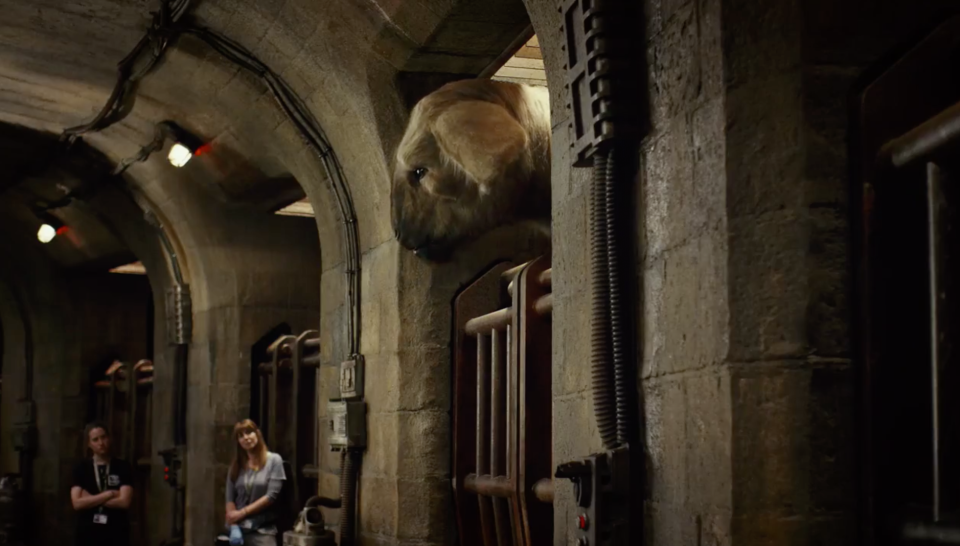
Where they ended up, and it was such a refinement at the very end, we were literally making them inches lower, we were testing against arches and streets and the ability for the camera to capture something like that. Cinematographers have enough trouble just shooting a man on a horse! It’s really hard when you think about it, exactly where you put the camera: what do you point it at? And just remembering that the animal is moving and you’re always trying to show what’s going on from all different directions.
That was tricky.
The landspeeder vehicles on Crait that the Rebels find and learn how to fly very quickly, there was a whole sequence inside the base where they found them and fixed them up and got them going. There were a lot of things like that that fell by the wayside when it was clear that the edit really didn’t require those elements. It all figured into the final designs for those craft.
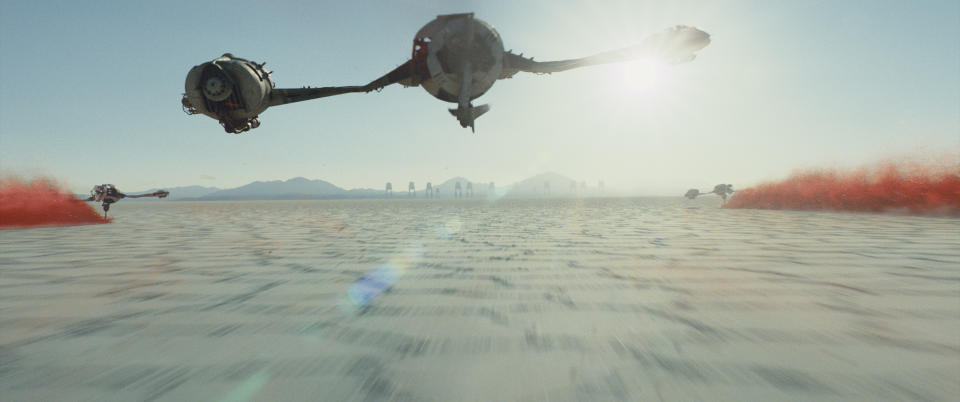
The landspeeder, the fact that it was offset, there was sort of an informal symmetry to it, that it was a hydrofoil, that it was elevated; those were all things that really took a while to arrive at. At the same time, we looked at different, less well known space vehicles that Ralph and Joe had designed, we did a mashup of some of those elements in a very basic way and took it from there to make sure it felt like a vehicle that could really be doing what it does.
Weirdly it does really look like it’s doing what it’s doing, although essentially what it’s doing is completely impossible and the laws of physics probably wouldn’t allow it to do that…
Do you have a personal favourite piece of design from the Star Wars iconography past and present? Anything you think ‘I would have loved to have designed that’…
It’s probably pretty prosaic but I’ve always loved the Millennium Falcon as a pure design piece.
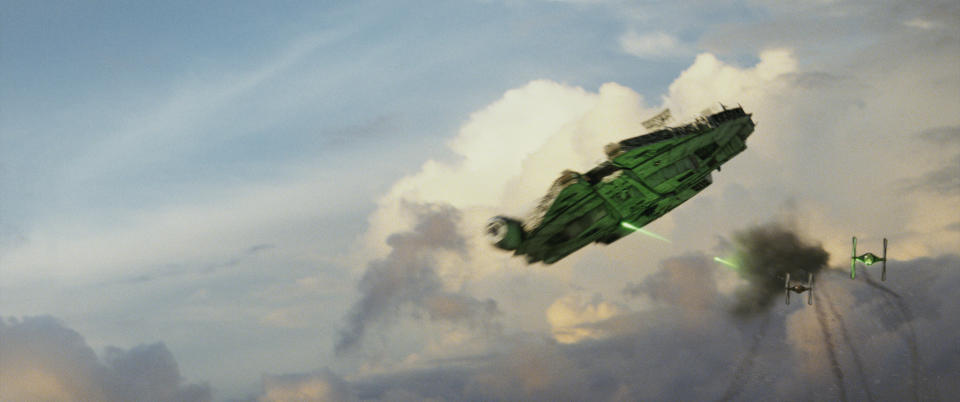
I loved the story behind it, how it evolved, it really did look like something else and they rehashed it. Lucas wanted to change it at the last minute because it was looking too much like something in Galaxy Quest or whatever that show was. And in fact it doesn’t look anything like it.
[Editor’s note: This article on the complete history of the Millennium Falcon design is essential reading]
What they ended up with is really such a pure essence of Lucas’s design mandate: that it be a metaphorical object, that it be reduced to its simplest parts, but that there’s a level of detail that allows the viewer to understand it and feel it and become engaged in everything, to have a kind of relationship with it. It’s just a really remarkable piece of design work.
What did you make of the critical reception to The Last Jedi in certain quarters of the fandom? Elements like Luke’s eventual fate have split fans in ways that Star Wars movies have never done before. What did you make of that?
I fully supported Rian’s decision regarding Luke.
I think it’s always tough to see the end of a beloved character like that and everybody owns that character so it was always going to be a very difficult decision. But what I loved about Rian’s approach was that each one of the characters’ stories were supporting an overall story arc, and that being the director that he is, Rian was always mindful it wasn’t just one character’s story, he was juggling all of them.
I think that history is going to look kindly on Episode VIII, I think it’s an incredible film, I think that it’s a dynamic film and that in many respects it’s clearing the way for an amazing Episode IX.
I have a feeling this isn’t the last you’re going to see of Luke Skywalker… That’s only a guess! I’m not allowed into the inner sanctum!
Star Wars: The Last Jedi will be released via Digital Download, 4K Ultra HD, Blu-ray and DVD on Monday, 9 April.
Hear what Rian Johnson and Mark Hamill had to say about Luke’s The Last Jedi arc below…
Read more
Solo to debut at Cannes
Rogue One was in ‘terrible’ shape before reshoots
Movies that were spoiled before release

 Yahoo Movies
Yahoo Movies 
